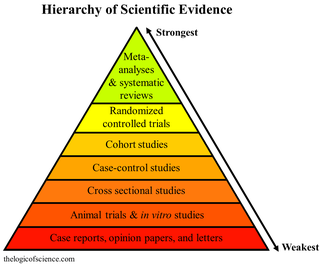Related Research Articles
Hypnotherapy is a type of mind–body intervention in which hypnosis is used to create a state of focused attention and increased suggestibility in the treatment of a medical or psychological disorder or concern. Popularized by 17th and 18th century psychologists such as James Braid and Milton H. Erickson.

A meta-analysis is a statistical analysis that combines the results of multiple scientific studies. Meta-analyses can be performed when there are multiple scientific studies addressing the same question, with each individual study reporting measurements that are expected to have some degree of error. The aim then is to use approaches from statistics to derive a pooled estimate closest to the unknown common truth based on how this error is perceived. Meta-analytic results are considered the most trustworthy source of evidence by the evidence-based medicine literature.
In published academic research, publication bias occurs when the outcome of an experiment or research study biases the decision to publish or otherwise distribute it. Publishing only results that show a significant finding disturbs the balance of findings in favor of positive results. The study of publication bias is an important topic in metascience.

Ole Ivar Løvaas was a Norwegian-American clinical psychologist and professor at the University of California, Los Angeles. He is most well known for his research on what is now called applied behavior analysis (ABA) to teach autistic children through prompts, modeling, and positive reinforcement. The therapy is also noted for its use of aversives (punishment) to reduce undesired behavior, however these are now used less commonly than in the past.
In medical research, a dynamic treatment regime (DTR), adaptive intervention, or adaptive treatment strategy is a set of rules for choosing effective treatments for individual patients. Historically, medical research and the practice of medicine tended to rely on an acute care model for the treatment of all medical problems, including chronic illness. Treatment choices made for a particular patient under a dynamic regime are based on that individual's characteristics and history, with the goal of optimizing his or her long-term clinical outcome. A dynamic treatment regime is analogous to a policy in the field of reinforcement learning, and analogous to a controller in control theory. While most work on dynamic treatment regimes has been done in the context of medicine, the same ideas apply to time-varying policies in other fields, such as education, marketing, and economics.
Paul Meier was a statistician who promoted the use of randomized trials in medicine.
Marie Diener-West is the Helen Abbey and Margaret Merrell Professor of Biostatistics and the chair of the Master of Public Health Program at Johns Hopkins Bloomberg School of Public Health. Diener-West is an editor for the Cochrane Eyes and Vision Group and a member of the American Public Health Association, American Statistical Association, Association for Research in Vision and Ophthalmology, and the Society for Clinical Studies.
Marvin Zelen was Professor Emeritus of Biostatistics in the Department of Biostatistics at the Harvard T.H. Chan School of Public Health (HSPH), and Lemuel Shattuck Research Professor of Statistical Science. During the 1980s, Zelen chaired HSPH's Department of Biostatistics. Among colleagues in the field of statistics, he was widely known as a leader who shaped the discipline of biostatistics. He "transformed clinical trial research into a statistically sophisticated branch of medical research."

Calvin Zippin is a cancer epidemiologist and biostatistician, and Professor Emeritus in the Department of Epidemiology and Biostatistics at the University of California School of Medicine in San Francisco (UCSF). He is a Fellow of the American Statistical Association, the American College of Epidemiology and the Royal Statistical Society of Great Britain. His doctoral thesis was the basis for the Zippin Estimator, a procedure for estimating wildlife populations using data from trapping experiments. He was a principal investigator in the Surveillance, Epidemiology, and End Results (SEER) program of the National Cancer Institute (NCI) which assesses the magnitude and nature of the cancer problem in the United States. In 1961, he created training programs for cancer registry personnel, which he conducted nationally and internationally. He carried out research on the epidemiology and rules for staging of various cancers. He received a Lifetime Achievement and Leadership Award from the NCI in 2003.
Marie Davidian is an American biostatistician known for her work in longitudinal data analysis and precision medicine. She is the J. Stuart Hunter Distinguished Professor of Statistics at North Carolina State University. She was president of the American Statistical Association for 2013.
Ann Dryden Witte is an American economist, known for her work on "a variety of interesting and eclectic problems" and as a "prolific author of books, monographs, and professional articles". She is a professor emerita of economics at Wellesley College, and a research associate of the National Bureau of Economic Research.
Ewout W. Steyerberg is Professor of Clinical Biostatistics and Medical Decision Making at Leiden University Medical Center and a Professor of Medical Decision Making at Erasmus MC. He is interested in a wide range of statistical methods for medical research, but is mainly known for his seminal work on prediction modeling, which was stimulated by various research grants including a fellowship from the Royal Netherlands Academy of Arts and Sciences (KNAW). Steyerberg is one of the most cited researchers from the Netherlands. He has published over 1000 peer-reviewed articles according to PubMed, many in collaboration with clinical researchers, both in methodological and medical journals. His h-index exceeds 150 according to Google Scholar.
Dalene Kay Stangl is an American statistician known for development and promotion of Bayesian statistical methods in health-related research.
Susan S. Ellenberg is an American statistician specializing in the design of clinical trials and in the safety of medical products. She is a professor of biostatistics, medical ethics and health policy in the Perelman School of Medicine at the University of Pennsylvania. She was the 1993 president of the Society for Clinical Trials and the 1999 President of the Eastern North American Region of the International Biometric Society.
Ross L. Prentice is a Canadian statistician known particularly for his contributions to survival analysis and statistical methods for epidemiology. He has worked at the Fred Hutchinson Cancer Research Center in 1974 and is also a professor of biostatistics at the University of Washington School of Public Health.
Janet Turk Wittes is an American statistician known for her work on clinical trials.
Patricia Louise Meller Grambsch is an American biostatistician known for her work on survival models including proportional hazards models. She is an associate professor emerita of biostatistics at the University of Minnesota.

Roderick Joseph Alexander Little is an academic statistician, whose main research contributions lie in the statistical analysis of data with missing values and the analysis of complex sample survey data. Little is Richard D. Remington Distinguished University Professor of Biostatistics in the Department of Biostatistics at the University of Michigan, where he also holds academic appointments in the Department of Statistics and the Institute for Social Research.
Guosheng Yin is a statistician, a data scientist, an educator and a researcher in Biostatistics, Statistics and machine learning, AI. Presently, Guosheng Yin is Chair in Statistics in Department of Mathematics at Imperial College London. Previously, he served as the Head of Department and the Patrick S C Poon Endowed Chair in Statistics and Actuarial Science, at the University of Hong Kong. Before he joined the University of Hong Kong, Yin worked at the University of Texas M.D. Anderson Cancer Center till 2009 as a tenured Associate Professor of Biostatistics.
Nancy A. Obuchowski is an American biostatistician whose research concerns the accuracy of image-based medical diagnoses, including the use of nonparametric statistics, receiver operating characteristic curves, and accounting for the effects of clustered data in this application. She works at the Lerner Research Institute of the Cleveland Clinic as vice chair of Quantitative Health Sciences, with a joint appointment in the Department of Diagnostic Radiology. She is also a professor in the Cleveland Clinic Lerner College of Medicine of Case Western Reserve University.
References
- 1 2 "Elisa T. Lee, Ph.D.", Faculty and Staff, University of Oklahoma Health Sciences Center , retrieved 2017-10-21
- 1 2 3 4 5 "Lee, Elisa T. 1939–", Gale Contemporary Authors, retrieved 2017-10-21
- ↑ Reviews of Statistical Methods for Survival Data Analysis: Sylvan B. Green (December 1982), Contemporary Clinical Trials 3 (4): 386–390, doi:10.1016/0197-2456(82)90030-7; Eric R. Ziegel (February 1993), Technometrics 35 (1): 101, doi:10.2307/1269320; Peter A. Lachenbruch (1993), Journal of the American Statistical Association 88 (421): 380; John O'Quigley (April 1994), Statistics in Medicine 13 (8): 883–884, doi:10.1002/sim.4780130812; A. González (1994), Biometrical Journal 36 (1): 16, doi:10.1002/bimj.4710360103; Robert Gentleman (2004), Journal of the American Statistical Association 99 (466): 572; Madhuchhanda Bhattacharjee (October 2005), Statistical Methods in Medical Research 14 (5): 535–536, doi:10.1177/096228020501400517; Patrick G Arbogast (October 2005), Clinical Trials 2 (5): 465–466, doi:10.1191/1740774505cn117xx; Brenda W. Gillespie (2015), International Statistical Review 83 (1): 167–168, doi:10.1111/insr.12095.